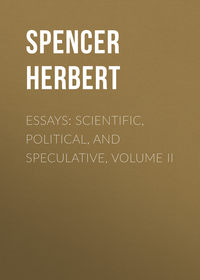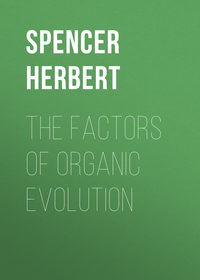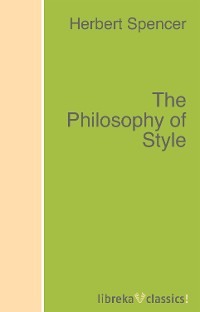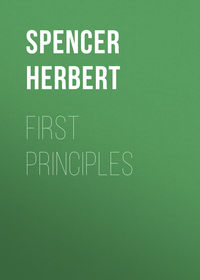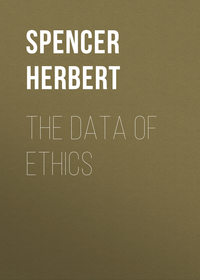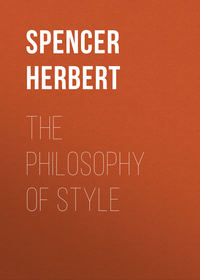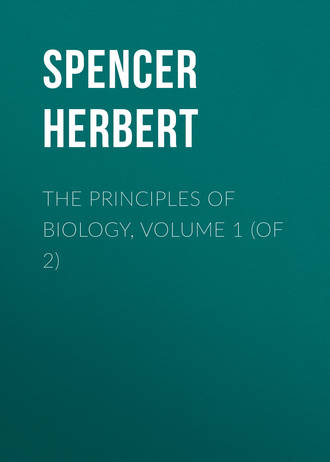 полная версия
полная версияThe Principles of Biology, Volume 1 (of 2)
But the clearest proof that structural alterations caused by alterations of function are inherited, occurs when the alterations are morbid. I had originally named in this place the results of M. Brown-Sequard's experiments on guinea-pigs, showing that those which had been artificially made epileptic had offspring which were epileptic; and I name them again though his inference is by many rejected. For, as exemplified a few pages back, strong evidence is often disregarded for trivial reasons by those who dislike the conclusion drawn. Just naming this evidence and its possible invalidity, let me pass to some results of experiences recently set forth by Dr. Savage, President of the Neurological Society. In an essay on "Heredity and Neurosis" published in Brain, Parts LXXVII, LXXVIII, 1897, he says: – "We recognise the transmission of a tendency to develop gout, and we recognise that the disease produced by the individual himself differs little from that which may have been inherited." [That is, acquired gout may be transmitted as constitutional gout.] "I have seen several patients whose history I have been able to examine carefully, in whom mental tricks have been transmitted from one generation to another." In the "musical prodigies" descending from musical parents, "there seemed to be a transmission of a greatly increased aptitude or tendency which is all one is contending for." "Though there is, in my opinion, power to transmit acquired peculiarities, yet the tendency is to transmit a predisposition." (pp. 19-21.) And an authority on nervous diseases who is second to none – Dr. Hughlings Jackson – takes the same view. The liability to consumption shown by children of consumptive parents, which no one doubts, shows us the same thing. It is admitted that consumption may be produced by conditions very unfavourable to life; and unless it is held that the disease so produced differs from the disease when inherited, the conclusion must be that here, too, there is a transmission of functionally-produced organic changes. This holds true whether the production of tubercle is due to innate defect or whether it is due to the invasion of a bacillus. For in this last case the consumptive diathesis must be regarded as a state of body more than usually liable to invasion by the bacillus, and this is the same when acquired as when transmitted.
§ 83. Two modified manifestations of Heredity remain to be noticed. The one is the re-appearance in offspring of traits not borne by the parents, but borne by the grandparents or by remoter ancestors. The other is the limitation of Heredity by sex – the restriction of transmitted peculiarities to offspring of the same sex as the parent possessing them.
Atavism, which is the name given to the recurrence of ancestral traits, is proved by many and varied facts. In the picture-galleries of old families, and on the monumental brasses in the adjacent churches, are often seen types of feature which are still, from time to time, repeated in members of these families. It is a matter of common remark that some constitutional diseases, such as gout and insanity, after missing a generation, will show themselves in the next. Dr. Struthers, in his above-quoted paper "On Variation in the Number of Fingers and Toes, and in the Phalanges in Man," gives cases of malformations common to grandparent and grandchild, but of which the parent had no trace. M. Girou (as quoted by Mr. Sedgwick) says – "One is often surprised to see lambs black, or spotted with black, born of ewes and rams with white wool, but if one takes the trouble to go back to the origin of this phenomena, it is found in the ancestors." Instances still more remarkable, in which the remoteness of the ancestors copied is very great, are given by Mr. Darwin. He points out that in crosses between varieties of the pigeon, there will sometimes re-appear the plumage of the original rock-pigeon, from which these varieties descended; and he thinks the faint zebra-like markings occasionally traceable in horses have probably a like meaning.
The other modified manifestation of heredity above referred to is the limitation of heredity by sex. In Mr. Sedgwick's essays, already named, will be found evidence implying that there exists some such tendency to limitation, which does or does not show itself distinctly according to the nature of the organic modification to be conveyed. On joining to the evidence he gives certain bodies of allied evidence we shall, I think, find the inconsistences comprehensible.
Beyond the familiar facts that in ourselves, along with the essential organs of sex there go minor structures and traits distinctive of sex, such as the beard and the voice in man, we have numerous cases in which, along with different sex-organs there go general differences, sometimes immense and often conspicuous. We have those in which (as in sundry parasites) the male is extremely small compared with the female; we have those in which the male is winged and the female wingless; we have those, as among birds, in which the plumage of males contrasts strongly with that of females; and among butterflies we have kindred instances in which the wings of the two sexes are wholly unlike – some, indeed, in which there is not simply dimorphism but polymorphism: two kinds of females both differing from the male. How shall we range these facts with the ordinary facts of inheritance? Without difficulty if heredity results from the proclivity which the component units contained in a germ-cell or a sperm-cell have to arrange themselves into a structure like that of the structure from which they were derived. For the obvious corollary is that where there is gamogenesis there will result partly concurring and partly conflicting proclivities. In the fertilized germ we have two groups of physiological units, slightly different in their structures. These slightly-different units severally multiply at the expense of the nutriment supplied to the unfolding germ – each kind moulding this nutriment into units of its own type. Throughout the process of development the two kinds of units, mainly agreeing in their proclivities and in the form which they tend to build themselves into, but having minor differences, work in unison to produce an organism of the species from which they were derived, but work in antagonism to produce copies of their respective parent-organisms. And hence ultimately results an organism in which traits of the one are mixed with traits of the other; and in which, according to the predominance of one or other group of units, one or other sex with all its concomitants is produced.
If so, it becomes comprehensible that with the predominance of either group, and the production of the same sex as that of the parent whence it was derived, there will go the repetition not only of the minor sex-traits of that parent but also of any peculiarities he or she possessed, such as monstrosities. Since the two groups are nearly balanced, and since inheritance is never an average of the two parents but a mixture of traits of the one with traits of the other, it is not difficult to see why there should be some irregularity in the transmission of these monstrosities and constitutional tendencies, though they are most frequently transmitted only to those of the same sex.37
§ 84. Unawares in the last paragraph there has been taken for granted the truth of that suggestion concerning Heredity ventured in § 66. Anything like a positive explanation is not to be expected in the present stage of Biology, if at all. We can look for nothing beyond a simplification of the problem; and a reduction of it to the same category with certain other problems which also admit of hypothetical solutions only. If an hypothesis which sundry widespread phenomena have already thrust upon us, can be shown to render the phenomena of Heredity more intelligible than they at present seem, we shall have reason to entertain it. The applicability of any method of interpretation to two different but allied classes of facts, is evidence of its truth.
The power which many animals display of reproducing lost parts, we saw to be inexplicable except on the assumption that the units of which any organism is built have a tendency to arrange themselves into the shape of that organism (§ 65). This power is sufficiently remarkable in cases where a lost limb or tail is replaced, but it is still more remarkable in cases where, as among some annelids, the pieces into which an individual is cut severally complete themselves by developing heads and tails, or in cases like that of the Holothuria, which having, when alarmed, ejected its viscera, reproduces them. Such facts compel us to admit that the components of an organism have a proclivity towards a special structure – that the adult organism when mutilated exhibits that same proclivity which is exhibited by the young organism in the course of its normal development. As before said, we may, for want of a better name, figuratively call this power organic polarity: meaning by this phrase nothing more than the observed tendency towards a special arrangement. And such facts as those presented by the fragments of a Hydra, and by fragments of leaves from which complete plants are produced, oblige us to recognize this proclivity as existing throughout the tissues in general – nay, in the case of the Begonia phyllomaniaca, obliges us to recognize this proclivity as existing in the physiological units contained in each undifferentiated cell. Quite in harmony with this conclusion, are certain implications since noticed, respecting the characters of sperm-cells and germ-cells. We saw sundry reasons for rejecting the supposition that these are highly-specialized cells and for accepting the opposite supposition, that they are cells differing from others rather in being unspecialized. And here the assumption to which we seem driven by the ensemble of the evidence, is, that sperm-cells and germ-cells are essentially nothing more than vehicles in which are contained small groups of the physiological units in a fit state for obeying their proclivity towards the structural arrangement of the species they belong to.
If the likeness of offspring to parents is thus determined, it becomes manifest, à priori, that besides the transmission of generic and specific peculiarities, there will be a transmission of those individual peculiarities which, arising without assignable causes, are classed as "spontaneous." For if the assumption of a special arrangement of parts by an organism, is due to the proclivity of its physiological units towards that arrangement; then the assumption of an arrangement of parts slightly different from that of the species, implies physiological units slightly unlike those of the species; and these slightly-unlike physiological units, communicated through the medium of sperm-cell or germ-cell, will tend, in the offspring, to build themselves into a structure similarly diverging from the average of the species.
But it is not equally manifest that, on this hypothesis, alterations of structure caused by alterations of function must be transmitted to offspring. It is not obvious that change in the form of a part, caused by changed action, involves such change in the physiological units throughout the organism that these, when groups of them are thrown off in the shape of reproductive centres, will unfold into organisms that have this part similarly changed in form. Indeed, when treating of Adaptation (§ 69), we saw that an organ modified by increase or decrease of function, can but slowly re-act on the system at large, so as to bring about those correlative changes required to produce a new equilibrium; and yet only when such new equilibrium has been established, can we expect it to be fully expressed in the modified physiological units of which the organism is built – only then can we count on a complete transfer of the modification to descendants. Nevertheless, that changes of structure caused by changes of action must also be transmitted, however obscurely, appears to be a deduction from first principles – or if not a specific deduction, still, a general implication. For if an organism A, has, by any peculiar habit or condition of life, been modified into the form A′, it follows that all the functions of A′, reproductive function included, must be in some degree different from the functions of A. An organism being a combination of rhythmically-acting parts in moving equilibrium, the action and structure of any one part cannot be altered without causing alterations of action and structure in all the rest; just as no member of the Solar System could be modified in motion or mass, without producing rearrangements throughout the whole Solar System. And if the organism A, when changed to A′, must be changed in all its functions; then the offspring of A′ cannot be the same as they would have been had it retained the form A. That the change in the offspring must, other things equal, be in the same direction as the change in the parent, appears implied by the fact that the change propagated throughout the parental system is a change towards a new state of equilibrium – a change tending to bring the actions of all organs, reproductive included, into harmony with these new actions. Or, bringing the question to its ultimate and simplest form, we may say that as, on the one hand, physiological units will, because of their special polarities, build themselves into an organism of a special structure; so, on the other hand, if the structure of this organism is modified by modified function, it will impress some corresponding modification on the structures and polarities of its units. The units and the aggregate must act and re-act on each other. If nothing prevents, the units will mould the aggregate into a form in equilibrium with their pre-existing polarities. If, contrariwise, the aggregate is made by incident actions to take a new form, its forces must tend to re-mould the units into harmony with this new form. And to say that the physiological units are in any degree so re-moulded as to bring their polar forces towards equilibrium with the forces of the modified aggregate, is to say that when separated in the shape of reproductive centres, these units will tend to build themselves up into an aggregate modified in the same direction.
Note. – A large amount of additional evidence supporting the belief that functionally produced modifications are inherited, will be found in Appendix B.
CHAPTER IX.
VARIATION
§ 85. Equally conspicuous with the truth that every organism bears a general likeness to its parents, is the truth that no organism is exactly like either parent. Though similar to both in generic and specific traits, and usually, too, in those traits which distinguish the variety, it diverges in numerous traits of minor importance. No two plants are indistinguishable; and no two animals are without differences. Variation is co-extensive with Heredity.
The degrees of variation have a wide range. There are deviations so small as to be not easily detected; and there are deviations great enough to be called monstrosities. In plants we may pass from cases of slight alteration in the shape of a leaf, to cases where, instead of a flower with its calyx above the seed-vessel, there is produced a flower with its calyx below the seed-vessel; and while in one animal there arises a scarcely noticeable unlikeness in the length or colour of the hair, in another an organ is absent or a supernumerary organ appears. Though small variations are by far the most general, yet variations of considerable magnitude are not uncommon; and even those variations constituted by additions or suppressions of parts, are not so rare as to be excluded from the list of causes by which organic forms are changed. Cattle without horns are frequent. Of sheep there are horned breeds and breeds that have lost their horns. At one time there existed in Scotland a race of pigs with solid feet instead of cleft feet. In pigeons, according to Mr. Darwin, "the number of the caudal and sacral vertebræ vary; as does the number of the ribs, together with their relative breadth and the presence of processes."
That variations, both small and large, which arise without any specific assignable cause, tend to become hereditary, was shown in the last chapter. Indeed the evidence which proves Heredity in its smaller manifestations is the same evidence which proves Variation; since it is only when there occur variations that the inheritance of anything beyond the structural peculiarities of the species can be proved. It remains here, however, to be observed that the transmission of variations is itself variable; and that it varies both in the direction of decrease and in the direction of increase. An individual trait of one parent may be so counteracted by the influence of the other parent, that it may not appear in the offspring; or, not being so counteracted, the offspring may possess it, perhaps in an equal degree or perhaps in a less degree; or the offspring may exhibit the trait in even a still higher degree. Among illustrations of this, one must suffice. I quote it from the essay by Sir J. Struthers referred to in the last chapter.
"The great-great-grandmother, Esther P – (who married A – L – ), had a sixth little finger on one hand. Of their eighteen children (twelve daughters and six sons), only one (Charles) is known to have had digital variety. We have the history of the descendants of three of the sons, Andrew, Charles, and James.
"(1.) Andrew L – had two sons, Thomas and Andrew; and Thomas had two sons all without digital variety. Here we have three successive generations without the variety possessed by the great-grandmother showing itself.
"(2.) James L – , who was normal, had two sons and seven daughters, also normal. One of the daughters became Mrs. J – (one of the informants), and had three daughters and five sons, all normal except one of the sons, James J – , now æt. 17, who had six fingers on each hand…
"In this branch of the descendants of Esther, we see it passing over two generations and reappearing in one member of the third generation, and now on both hands.
"(3.) Charles L – , the only child of Esther who had digital variety, had six fingers on each hand. He had three sons, James, Thomas, and John, all of whom were born with six fingers on each hand, while John has also a sixth toe on one foot. He had also five other sons and four daughters, all of whom were normal.
"(a.) Of the normal children of this, the third generation, the five sons had twelve sons and twelve daughters, and the four daughters have had four sons and four daughters, being the fourth generation, all of whom were normal. A fifth generation in this sub-group consists as yet of only two boys and two girls who are also normal.
"In this sub-branch, we see the variety of the first generation present in the second, passing over the third and fourth, and also the fifth as far as it has yet gone.
"(b.) James had three sons and two daughters, who are normal.
"(c.) Thomas had four sons and five daughters, who are normal; and has two grandsons, also normal.
"In this sub-branch of the descent, we see the variety of the first generation, showing itself in the second and third, and passing over the fourth, and (as far as it yet exists) the fifth generation.
"(d.) John L – (one of the informants) had six fingers, the additional finger being attached on the outer side, as in the case of his brothers James and Thomas. All of them had the additional digits removed. John has also a sixth toe on one foot, situated on the outer side. The fifth and sixth toes have a common proximal phalange, and a common integument invests the middle and distal phalanges, each having a separate nail.
"John L – has a son who is normal, and a daughter, Jane, who was born with six fingers on each hand and six toes on each foot. The sixth fingers were removed. The sixth toes are not wrapped with the fifth as in her father's case, but are distinct from them. The son has a son and daughter, who, like himself, are normal.
"In this, the most interesting sub-branch of the descent, we see digital increase, which appeared in the first generation on one limb, appearing in the second on two limbs, the hands; in the third on three limbs, the hands and one foot; in the fourth on all the four limbs. There is as yet no fifth generation in uninterrupted transmission of the variety. The variety does not yet occur in any member of the fifth generation of Esther's descendants, which consists, as yet, only of three boys and one girl, whose parents were normal, and of two boys and two girls, whose grandparents were normal. It is not known whether in the case of the great-great-grandmother, Esther P – , the variety was original or inherited."38
§ 86. Where there is great uniformity among the members of a species, the divergences of offspring from the average type are usually small; but where, among the members of a species, considerable unlikenesses have once been established, unlikenesses among the offspring are frequent and great. Wild plants growing in their natural habitats are uniform over large areas, and maintain from generation to generation like structures; but when cultivation has caused appreciable differences among the members of any species of plant, extensive and numerous deviations are apt to arise. Similarly, between wild and domesticated animals of the same species, we see the contrast that though the homogeneous wild race maintains its type with great persistence, the comparatively heterogeneous domestic race frequently produces individuals more unlike the average type than the parents are.
Though unlikeness among progenitors is one antecedent of variation, it is by no means the sole antecedent. Were it so, the young ones successively born to the same parents would be alike. If any peculiarity in a new organism were a direct resultant of the structural differences between the two organisms which produced it; then all subsequent new organisms produced by these two would show the same peculiarity. But we know that the successive offspring have different peculiarities: no two of them are ever exactly alike.
One cause of such structural variation in progeny, is functional variation in parents. Proof of this is given by the fact that, among progeny of the same parents, there is more difference between those begotten under different constitutional states than between those begotten under the same constitutional state. It is notorious that twins are more nearly alike than children borne in succession. The functional conditions of the parents being the same for twins, but not the same for their brothers and sisters (all other antecedents being constant), we have no choice but to admit that variations in the functional conditions of the parents, are the antecedents of those greater unlikenesses which their brothers and sisters exhibit.
Some other antecedent remains, however. The parents being the same, and their constitutional states the same, variation, more or less marked, still manifests itself. Plants grown from seeds out of one pod, or animals produced at one birth, are not alike. Sometimes they differ considerably. In a litter of pigs or of kittens, we rarely see uniformity of markings; and occasionally there are important structural contrasts. I have myself recently been shown a litter of Newfoundland puppies, some of which had four digits to their feet, while in others there was present, on each hind-foot, what is called the "dew-claw" – a rudimentary fifth digit.
Thus, induction points to three causes of variation, all in action together. We have heterogeneity among progenitors, which, did it act uniformly and alone in generating, by composition of forces, new deviations, would impress such new deviations to the same extent on all offspring of the same parents; which it does not. We have functional variation in the parents, which, acting either alone or in combination with the preceding cause, would entail the same structural variations on all young ones simultaneously produced; which it does not. Consequently there is some third cause of variation, yet to be found, which acts along with the structural and functional variations of ancestors and parents.
§ 87. Already, in the last section, there has been implied some relation between variation and the action of external conditions. The above-cited contrast between the uniformity of a wild species and the multiformity of the same species when cultivated or domesticated, thrusts this truth upon us. Respecting the variations of plants, Mr. Darwin remarks that "'sports' are extremely rare under nature, but far from rare under cultivation." Others who have studied the matter assert that if a species of plant which, up to a certain time, has maintained great uniformity, once has its constitution thoroughly disturbed, it will go on varying indefinitely. Though, in consequence of the remoteness of the periods at which they were domesticated, there is a lack of positive proof that our extremely variable domestic animals have become variable under the changed conditions implied by domestication, having been previously constant; yet competent judges do not doubt that this has been the case.


